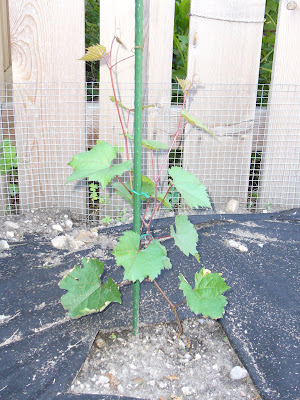After a lot of reading and internet scouring, the vine variety has been selected:
Marquette. In spite of my general distaste for Marquette University, this vine appears to fit my criteria the best.
Marquette is a hybrid vine, which means it is a cross between European and native American vines. The well-known European varieties (Cabernet Sauvignon, Merlot, Chardonnay, Pinot Noir, Riesling, etc) are all members of the species
vitis vinifera. Common American varieties have many species names, and include the common varieties Concord and Delaware, names which don't exactly conjure up thoughts of sublime wines (Motts and Ocean Spray are more up their alley). The catch is that those American varieites are (surprise, suprise) really good at dealing with the American climate and ecology: resistance to frigid winters and diseases being the most important.
Anyway, the goal of any hybrid is to capture the desirable characteristics of each parent. In this case, hybrid grape vines attempt to capture the winter hardiness and disease resistance of American vines, and the wine quality of European vines. How well does it work? Pretty well: the hardiness and disease resistance are fairly well replicated. The wine quality is a little tougher however. At their best, the hybrids I've had are quite enjoyable, whites Seyval Blanc and Cayuga are my favorites, but they are pretty far from the best wines I've ever tasted.
So why don't I try my luck with a
vitis vinifera variety? Is it possible to grow these vines in the midwest? Probably, but it's probably also a pain in the ass. I don't really know what the hell I'm doing, so a bit of idiot-proffness built into my vines appeals to me. Plus, I don't want to be spraying the vines all summer to ward off disease, only to worry all winter about whether they'll survive.
I'm also an engineer, and I like the idea of tinkering with a product to optimize its results. That is exactly what the University of Minnesota is doing with its viticulture hybridization program: churing out highly winter-hardy and disease-varieties to bolster their state's wine economy. Marquette is the newest release by UMN, and their review of the potential wine quality is downright
glowing. I'd prefer a Robert Parker-style independent review of the potential quality, but this will have to do.
The vines have been ordered and I patiently await their arrival sometime next week. In the meantime, I've been working like a dog getting the site ready. An update on the plot and some photos will follow shortly.
In the meantime, visit a
brother vineyard across the pond. Phil's got a LOT more vines than I'll have! Plus he's going whole hog:
vitis vinifera, and the toughest of them all, Pinot Noir. Good luck Phil! And while you're at it, the
best wine site on the internet, where Phil and I "met".



